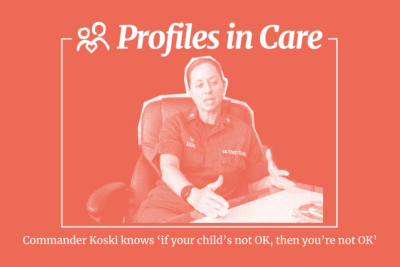
At the Oct. 6 meeting of the North Carolina Task Force on Child Care and Early Education, two child care providers were asked what advice they would give to their younger selves or to someone else thinking of opening a child care program in North Carolina.
“Don’t do it,” said Cassandra Brooks, owner and operator of Little Believer’s Academy, a five-star licensed child care center with locations in Wake and Johnston counties.
“At this time, I would also say, do not do it,” said Angelia Shipp, owner of Doletta Learning Center, a four-star licensed family child care home in Forsyth County.
Brooks and Shipp were part of a panel on emerging child care supply challenges, presenting their experiences to the task force. Their advice comes months after the end of the stabilization grants that helped keep the state’s child care sector afloat during and after the pandemic.
Without that public investment, child care providers aren’t able to pay themselves or their employees family-sustaining wages without raising tuition beyond what the families of their students can afford.
![]() Sign up for Early Bird, our newsletter on all things early childhood.
Sign up for Early Bird, our newsletter on all things early childhood.
After releasing its interim report in June, the bipartisan task force — established by Gov. Josh Stein earlier this year — is now working in subgroups to develop implementation strategies around these six recommendations, with the mission of solving the state’s child care crisis:
- Set a statewide child care subsidy reimbursement rate floor.
- Develop approaches to offer non-salary benefits to child care professionals.
- Explore partnerships with the University of North Carolina System, N.C. Community Colleges System, and K-12 public school systems to increase access to child care for public employees and students.
- Explore subsidized or free child care for child care teachers.
- Link existing workforce compensation and support programs for early childhood professionals into a cohesive set of supports.
- Explore the creation of a child care endowment to fund child care needs.
Here’s a look at some of the main takeaways from Monday’s task force meeting.
Updates from the task force
The meeting began with co-chair Democratic Lt. Gov. Rachel Hunt inviting members to share updates or comments on ways the federal government shutdown could affect family and child well-being in North Carolina.
Members discussed potential disruptions to military paychecks, Head Start renewals, and the federal supplemental nutrition program for women, infants, and children (WIC), depending on when the shutdown is resolved.
Next, the staffers for each of the task force’s three work groups reported on developments since their last full meeting on Aug. 4.
Kimberly Mallady, senior early childhood policy advisor for Division of Child Development and Early Education (DCDEE), reported on the work of the finance and funding group, which has been learning more about states that have endowment funds for child care.
Mallady said the group has met with experts from Nebraska, Connecticut, and Washington, D.C. to learn more about how their child care endowments operate. Next they’ll meet with leaders from Arizona, Iowa, Louisiana, Montana, and New Mexico — which recently announced a major expansion of how their endowment will be used to provide free universal child care statewide.
Madhu Vulimiri, senior advisor for health and families policy for Stein, shared the progress of the workforce compensation and supports group. They’ve been looking into how nine other states — Kentucky, Rhode Island, North Dakota, Texas, New Hampshire, Iowa, Washington, Arkansas and Maine — provide free or subsidized child care for the children of child care professionals.
Vulimiri shared that a recent survey conducted in North Carolina, “found that 61% of programs are already offering discounted care to their employees, which represents about a $31 million value in what they’re doing, but it also represents lost revenue for those programs.”
Vulimiri also noted two bills were introduced this session that would fund pilots to make child care professionals automatically eligible for child care subsidies for their own children between the age of 8 weeks and 5 years. House Bill 800 would apply specifically to teachers, and Senate Bill 593 would include teachers, teaching assistants, and administrators. Neither bill was passed by the chamber it originated in.
Samantha Cole, child care business liaison for the North Carolina Department of Commerce, reported on the progress of the group looking into providing child care support to public sector workers.
Cole said they’re working on identifying child care assets that are already available in local public schools, along with community college and UNC system campuses. In some cases these educational institutions are already offering child care on their campuses, she said, and in others they may have space to do so, but lack the resources.
Child care closures as an economic threat
Candace Witherspoon, director of DCDEE, introduced the panel on emerging challenges when it comes to the supply of child care across the state with some new data on the net loss of licensed child care in North Carolina.
“Just in the month of August, we had more than twice as many programs close as open,” Witherspoon said. “We had 47 closures and only 22 programs opened.”
The panelists were each well positioned to speak about this issue on a personal level. The panel featured Brooks and Shipp — both of whom may have to close their child care programs — along with a parent whose children attend a child care center that will close at the end of the year.
Brooks spoke from the heart about the challenges she has faced as a business owner since the end of stabilization grants earlier this year.
“No one wants to feel like a failure in any business they start,” Brooks said.
She noted that her centers do more than provide child care, they’re crucial lifelines for families. She shared the story of a single working mother who recently faced eviction and needed $2,000 to remain in her home. Brooks and her staff posted that need on their center’s Facebook page, and the community rallied around the family to keep them from experiencing homelessness.
Brooks began crying as she imagined what would have happened to that family if she had closed her center, and what might happen to other students’ families and her own staff “unless something changes dramatically.”
Brooks said that while she, her team, and other educators across the state love the work they do with young learners, “Love cannot pay your bills.”
Shipp finds herself in a similar — though perhaps more urgent — situation.
“I’ve got to make a decision by the end of this week of whether I’m going to continue in the field or close my doors,” Shipp told the task force.
She’s struggling to ends meet due to low enrollment because families are struggling to afford paying any tuition.
Shipp reminded task force members of what is at stake:
Without funding, we cannot sustain our homes. Our children are going to fall through the cracks, and that’s hard. It’s very hard. We know that when the children went back to school after covid, a lot of our children struggled. They are still struggling, and if parents cannot work, they’re going to struggle even more.
Erin Thomas Trant is worried she’ll be one of those parents.
Trant is a small business owner on Hatteras Island, who also works in real estate, and the mother of a 5-year-old son and 2.5-year-old twin boys.
She learned in July that the only licensed child care site on the island will close at the end of the year.
Witherspoon asked Trant what her reaction was when she learned her sons’ child care center would be closing.
“Tears,” Trant said. “My initial reaction was I was distraught and I was pissed off, to be frank.”
![]() Sign up for the EdDaily to start each weekday with the top education news.
Sign up for the EdDaily to start each weekday with the top education news.
The task force’s co-chair, Sen. Jim Burgin, R-Harnett, asked Trant about a number of potential options for keeping the island’s only licensed child care facility open, including relocating to a YMCA, Boys & Girls Club, local public school, or church.
Trant explained that as in many rural parts of the state, there is no YMCA or Boys & Girls Club on Hatteras. The schools on the island don’t have space, and the available spaces in churches do not meet the state’s child care licensure requirements.
She urged task force members to think of child care as an essential service, more like a hospital or fire station than a private business.
Without the essential service provided by her sons’ licensed child care center, she summed up her options: “Quitting my job, closing my business, or moving.”
Child care challenges as force-readiness threat
A second panel focused on child care for military families and featured Roderick White, the military and family services coordinator for North Carolina’s Department of Military and Veterans Affairs (NC DMVA); Dawn Rochelle, CEO of One Place in Onslow County; Staci Davis, youth and family services coordinator for New River YMCA; and Sarah Williams, compliance coordinator for Camp Lejeune-Marine Corps Air Station New River.
Susan Gale Perry, CEO of Child Care Aware of America, provided a brief overview of the military child care system ahead of the panel discussion.
Congress passed the Military Child Care Act of 1989 when the military’s child care crisis was seen as a threat to national security and the collective future of all Americans.
The military attacked the crisis on two fronts — supply and demand — both by investing the capital needed to build child care sites and train high-quality teachers, and by providing service members with subsidies to cover the cost of care.
Jenny Akin of Blue Star Families moderated the panel. She pointed out that even though the military’s child care model is often considered the gold standard for quality and affordability, service members face many of the same challenges as civilians when it comes to accessibility — plus additional challenges unique to their service.
She noted that the unemployment rate for the spouses of service members is 20%, due primarily to lack of child care.
Other challenges discussed by the panel included:
- Service members are not stationed near their extended families, so they cannot rely on grandparents or other kin for child care.
- Service members move frequently, which often means finding themselves at the end of child care waitlists in each new community they join.
- Single parents and families with both parents in the military need after hours, weekend, and overnight child care that is rarely available.
Both White and Rochelle noted these challenges pose a real threat to force readiness.
“I’m a crusty old sergeant major of 31 years, and I spent the majority of my life taking care of soldiers and their families,” White said. “And one thing that always is universal across the military, is if I can make sure that that soldier’s family is taken care of, he will be mission-focused.”
North Carolina is one of 19 locations participating in the Military Child Care in Your Neighborhood-PLUS program, enabling service members to use their stipends at child care programs that participate in state or local Quality Rating and Improvement Systems (QRIS).
But as panelists pointed out, that program has limited utility when the availability of high-quality licensed child care in North Carolina is limited, particularly in rural areas where many members of the Army National Guard, Air National Guard, and military reservists live.
“It boils back to family first, mission always, right?” White said. “So we have to make sure that we’re getting at these child care issues because in North Carolina, we want to be the most military friendly state, and this is one of the ways that we can be at the top, if we address this issue.”
The task force work groups will each meet independently before the next full meeting of the task force on Dec. 1, 2025.
Recommended reading



